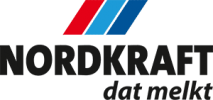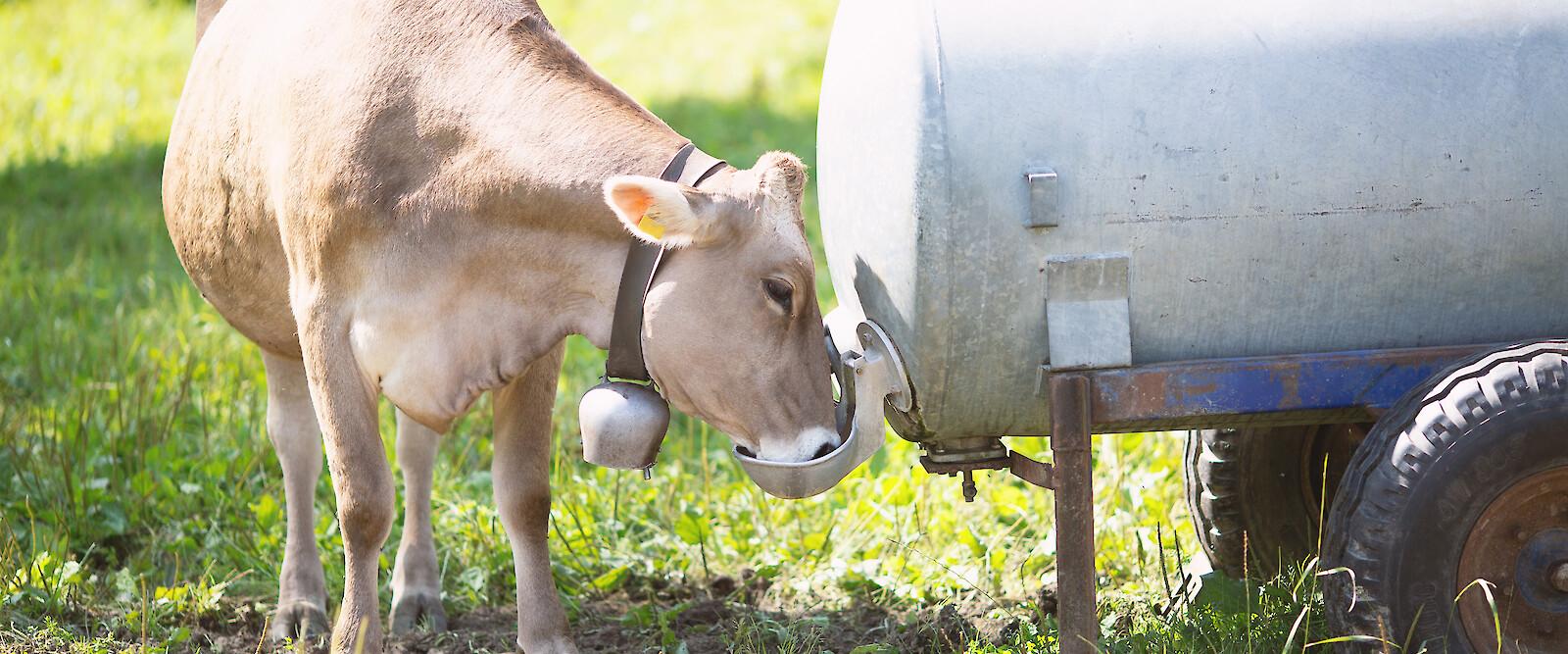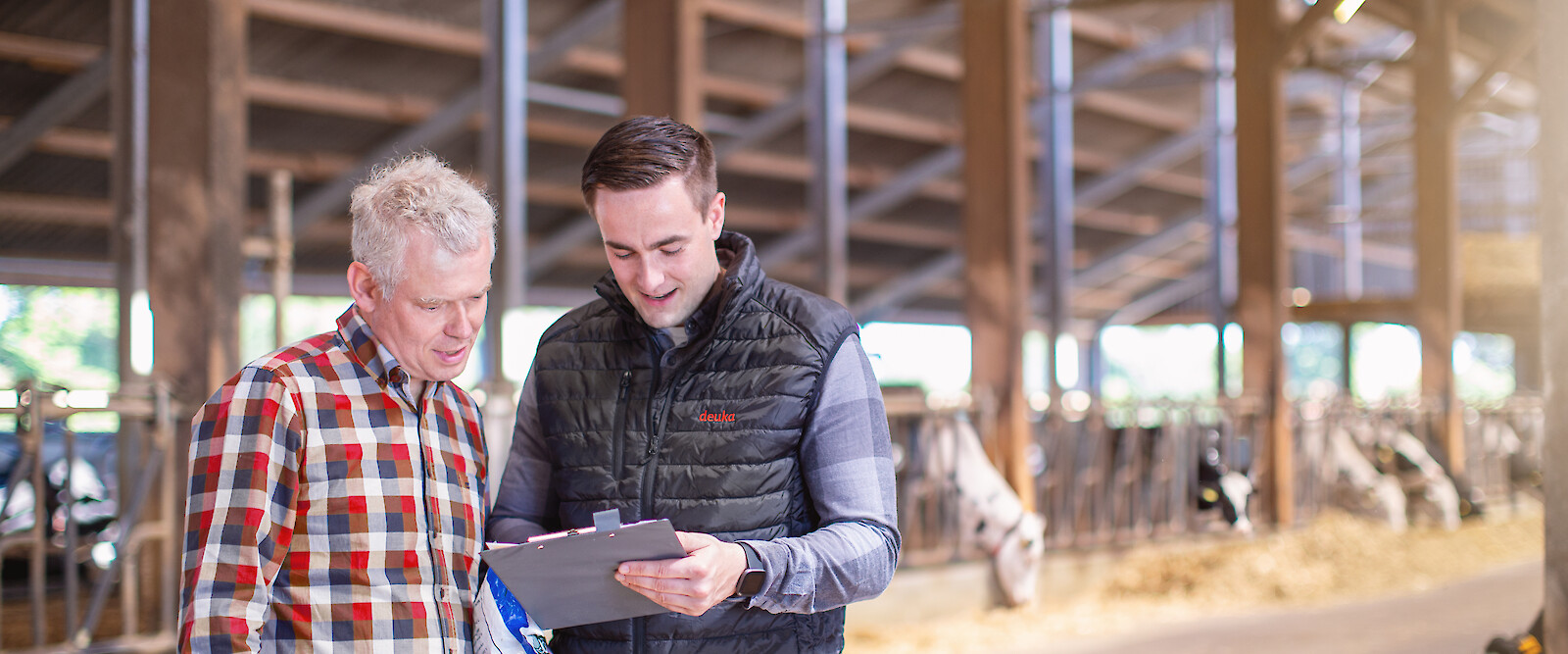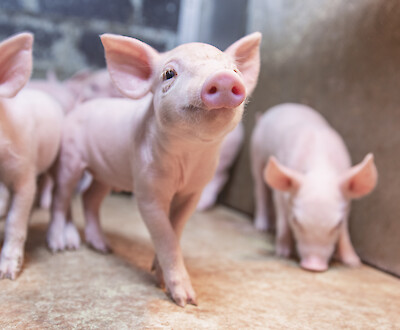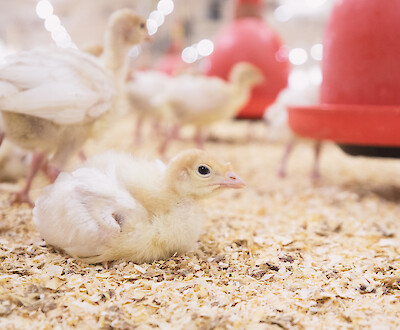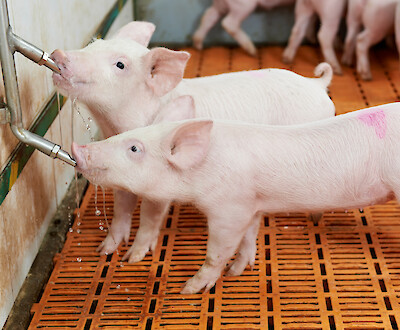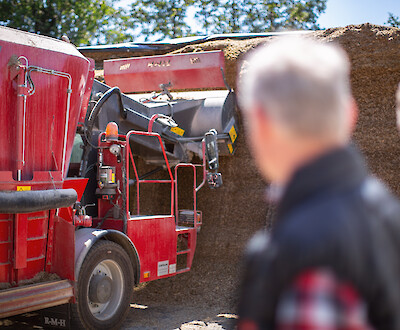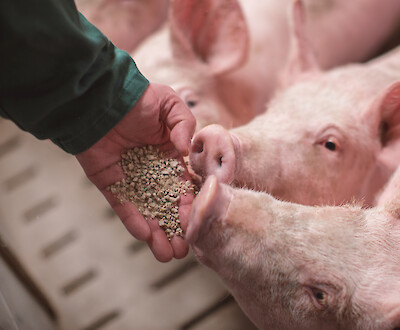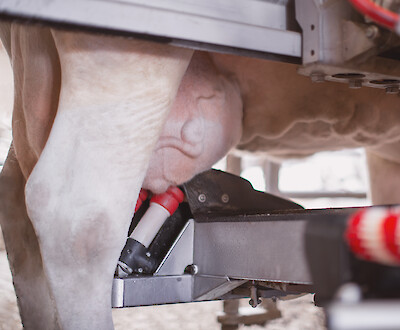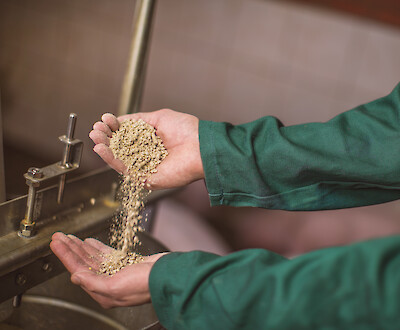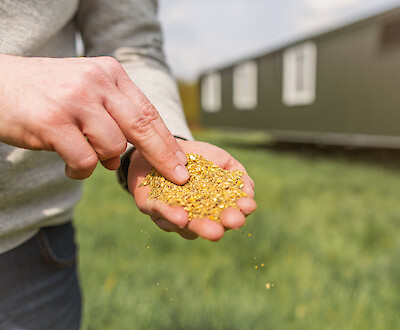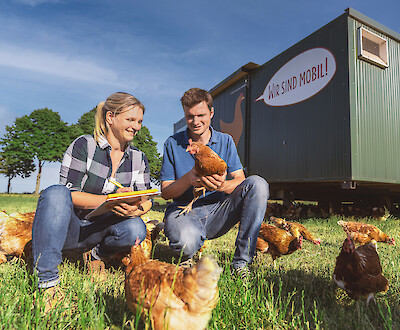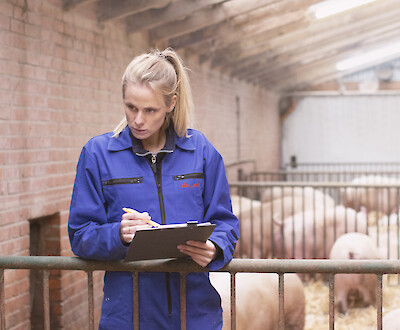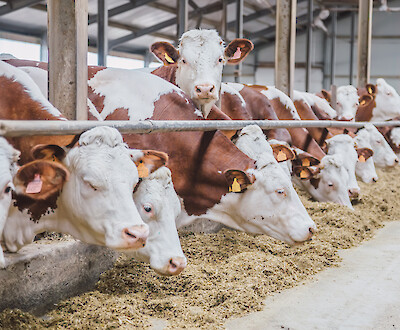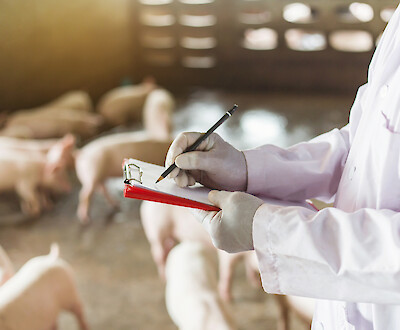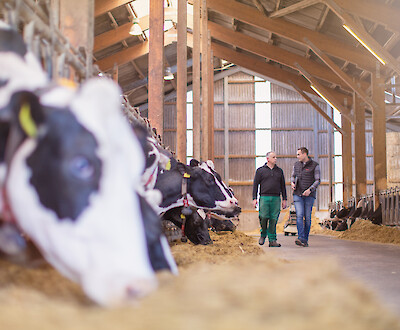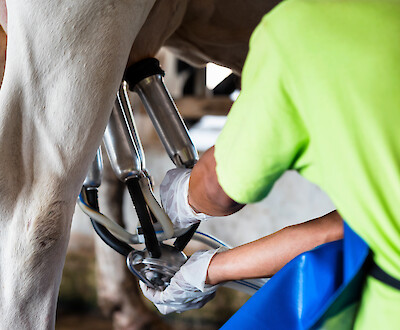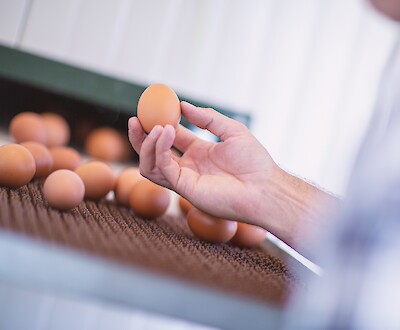Management and feeding tips for high temperatures in the barn
This works against heat stress in dairy cows
Cattle are sensitive to high temperatures - this is especially true for dairy cows. Native climatic conditions create heat stress for modern dairy breeds more often than in the past. Heat stress has a variety of effects on animal well-being and performance. In order to keep the cattle fit and to stabilize the milk yield at a high level, farmers are challenged. A number of measures can help. Feeding must be given special consideration in this context.
Heat stress is becoming increasingly important in the everyday lives of cattle farmers. The reason for this is global warming and the associated increase in weather extremes and hot spells. Germany is also affected by this. Another reason is the rapid performance development of dairy cattle in recent decades. With increasing performance, the animals produce more heat. Combined with increased outside temperatures, heat stress is a challenge in the barn more often and for longer periods of time.
Heat stress in dairy cows starts at these temperatures
The optimal temperature range for dairy cows is between 4 °C to 16 °C. This range is called the thermoneutral zone. It denotes the cow's comfort zone. Within the thermoneutral zone, animals do not need to expend additional energy to keep their body temperature stable. Heat production and release are in a harmonious balance. Farmers should try to keep the barn temperature within this range.
From 17 °C outside temperature, the cow leaves the optimal range for her well-being. Up to about 22 °C, feed conversion deteriorates slightly. However, performance depression is not yet to be expected. Above 22 °C, slight heat stress begins. Since the animals produce heat to varying degrees, critical temperature ranges are reached sooner or later, depending on milk yield.
In cows with a daily milk yield of 30 kg, severe heat stress is observed at a temperature of 28 to 34 °C. The higher the humidity in the barn, the earlier severe heat stress occurs. For animals with an output of 50 kg of milk per day, an outside temperature of 20 to 26 °C is already sufficient. As a result, the animals' respiratory rate increases to more than 80 breaths per minute.
![Table 1: Temperature range according to temperature-humidity index (THI) [mod. according to Zimbelmann & Collier, 2009] (© Deutsche Tiernahrung Cremer).](/site/assets/files/298990/grafik_darstellung_hitzestress_bei_kuehen_temperaturbereich_gemaess_temperatur-luftfeuchtigkeits-index_thi_c_deutsche_tiernahru.1000x0.jpg)
-
During heat stress, the cow's body temperature gradually rises. As this happens, the blood vessels dilate to promote heat release and the animals begin to sweat. By breathing more, they try to generate evaporative cooling to continue releasing heat. This behavior increases energy consumption. At the same time, the feed intake of heat-stressed animals drops - by up to 20%, depending on the situation - and they begin to select feed. The reduced basal feed intake eventually shifts the basal/concentrate ratio from its optimum (60:40) in favor of concentrate.
The reduced basal feed intake causes a decrease in rumination activity and the pH in the rumen decreases. However, a low pH means that microbial activity decreases and with it less microbial protein is produced. Thus, feed conversion also dwindles during heat stress and there is a risk of rumen acidosis (extreme over-acidification of the rumen), which can sometimes cause massive digestive problems.
Sweating in the summer months not only causes an increasing loss of fluids. Important minerals - especially sodium chloride (NaCl) and potassium - are also lost. If the loss is not compensated, there is a risk of a corresponding deficiency.
However, sharply increased temperatures not only impair the performance of dairy cows, but also that of calves. Metabolism and immunity are impaired. Consequently, their productivity also decreases.
Symptoms: How heat stress manifests itself in cows
Heat stress manifests itself differently from animal to animal. However, depending on the temperature and stress level, the following symptoms can be observed most frequently:
![Table 2: Temperature-humidity index (THI) in lactating dairy cattle [mod. after Zimbelmann & Collier, 2009] (© Deutsche Tiernahrung Cremer).](/site/assets/files/298999/grafik_darstellung_hitzestress_temperatur-luftfeuchtigkeits-index_thi_bei_laktierendem_milchvieh.1000x0.jpg)
Many ways lead to the goal: How to reduce heat stress in the barn
-
To combat heat stress, farmers can use a variety of cooling options. These include various ventilation or cooling systems, or a combination of both. Ventilation systems are usually referred to as fans. Their cooling effect is based on turbulence on the one hand and air exchange on the other. Cooling systems, on the other hand, affect the barn temperature through water vapor in the barn (high-pressure fogging) or act directly on the animals (low-pressure spraying).
- Finding the right ventilation management
- Ensure sufficient air movement in the barn. The required ventilation rate depends on the outside temperature and the performance of the animals.
- Weather-dependent, automatic adjustment of the ventilation and cooling systems is preferable to manual adjustment, since the heat sensations of humans and animals sometimes differ sensitively (optimally with thermostats in group switching).
- Activate ventilation and cooling systems also during night hours.
- Clean the protective grids of the fans regularly (maximum fan output).
- Check the priority in the free stall
- Position additional fans in critical areas (waiting area and milking parlor/robot).
- Position fans above the cubicles in the loose housing.
- If necessary, provide separate systems for transit cows.
- Installing the right technology correctly
- The installation of state-of-the-art cooling technology is essential to counteract heat stress. Since the individual conditions on site must always be taken into account, it is usually advisable to consult specialized ventilation experts.
- Finding the right ventilation management
-
In addition to using the right ventilation and cooling systems, it is also possible to relieve the animals of heat stress through barn management. Operational routines must be closely scrutinized, scrutinized and, if necessary, adjusted.
- Provide sufficient shade - both in the barn and on the pasture.
- Do not overcrowd the loose housing: The higher the cow density, the more heat is generated.
- Adjust milking times if necessary. Ideally, milk in the early morning hours.
- Reduce the number of animals in the pre-waiting area in the milking parlor, minimizing the time each animal spends there.
- Maximize the number of drinkers, ensure adequate -hygiene and/or increase the -flow rate if necessary - both in the pasture and in the barn.
- Move grazing times to night hours if necessary.
- Open the blinds of the side walls already from a temperature of 5 °C (if there is no frost).
- Open them to the maximum at a temperature of 10 °C at the latest.
- If possible, do not use wind brakes.
-
Farmers should already consider measures against heat stress when planning the construction of a barn. However, even older barns offer many possibilities for adaptation and optimization against heat stress.
- Align the barn building at right angles to the main wind direction.
- Create sufficient air intake and exhaust areas.
- Avoid dense, immovable side walls (i.e., no high plinth walls, etc.).
- Use open side walls that can be closed if necessary.
- Avoid attachments that restrict airflow.
- Plan for the largest possible air volumes (high eaves at least four feet high).
- Provide an open light ridge along the entire length of the barn. Do not choose wide ridges.
- Avoid unnecessary solar radiation (e.g. light panels in the occupied area).
- Insulate the roof and ensure light-colored surfaces.
- Also install ventilation systems in new, high barns.
Adapt feeding and management measures
Heat-stressed animals eat less. Feeding them according to their needs and performance is a particular challenge in spring and summer. Cattle farmers should regularly monitor feed intake. To keep an eye on the nutrient content of the feed, it is advisable to regularly determine the amount of dry matter (DM) consumed by the animals (see info box).
If farm managers notice a decrease in the amount of feed per animal, they should react quickly and precisely. The first step is to take farm-specific measures to maximize feed intake.
- Empty feed silos before each new feed delivery.
If feed residues remain, they can spoil and infect the entire silo. - Check silo hygiene regularly
Check silo hygiene regularly - especially at high temperatures. - Check grain storage regularly
In this way, you can detect an infestation of grain weevils, mites, etc. at an early stage so that you can take swift countermeasures if necessary. - Adjusting concentrate and grain meal storage to consumption
For both, you should aim for a maximum storage period of four to six weeks. - Protect silos from direct sunlight
Silage tends to sweat when exposed to strong sunlight. This favors the formation of mold.
- For ensiling: Ensure optimum compaction and complete air seal already during ensiling. Keep silos closed for at least four to six weeks after ensiling. If necessary, use silage additives to prevent faulty fermentation and reduce reheating after cutting.
- In the summer months: Use only stable forage and silage with a suitable pH value. The lower the DM content, the lower the pH of the silage must be to ensure good quality silage. Make sure the gating surfaces are smooth and discard unstable edge surfaces. Also, choose only a silo with feed (summer: > 20 cm/day; winter: > 40 cm/day). When using brewer's grains, ensure optimum ensiling (leave covered in silo to ferment for at least six weeks and then feed with sufficient feed). Do not feed heated silage and - if necessary - treat the cut surface with acids.
- Adjust the dry matter content of the ration by supplementing water
Reduce the DM content of the total ration to < 40%. This reduces feed selection and increases feed intake. Important: always provide fresh feed and stabilize the mixture if necessary. - Feed mainly in the evening
In hot weather, cows eat about 2/3 of their daily ration at night. Therefore, present the feed mainly in the evening hours. - Increase feeding interval
During heat stress, the animals' appetite is reduced. For this reason, feed more often, but smaller amounts of feed throughout the day. - Feed more often
Feed regularly to ensure that the animals always have access to sufficient feed. - Utilize the feed area to the maximum
Use the entire length of the feed table when distributing feed. This allows more animals to eat at the same time. - Optimize access to feed
Avoid overcrowding. If access to the feed table is blocked by animals, lower-ranking animals will have limited access to feed. - Maximize feeding times
Avoid too long waiting times in the milking parlor or during insemination and hoof care. The more time animals have to eat, the better. - Increase energy in trogration and adjust concentrate allocation
This increases the palatability of the base feed and promotes feed intake. - Feed less straw and structure
Digestion is otherwise associated with higher heat release, which (further) inhibits appetite. - Provide only palatable components
Feed only high quality silage. - Check basic feed regularly for reheating
Avoid intermediate feed storage. - Present new feed regularly
- Clean the feed table intensively before each feeding
How to determine the dry matter content of your ration
To calculate the dry matter (DM) of a ration, the following simple formula applies: Fresh matter (FM) x (dry matter content / 100) = dry matter (DM). Fresh matter (FM) refers to the total mass of the ration including (raw) water. To obtain the DM, you must first determine the DM content in an intermediate step. This is obtained by removing the water from fresh ration samples (e.g. by drying in a microwave, oven or dehydrator). The difference between the initial weight and the final weight is the DM content of the ration.
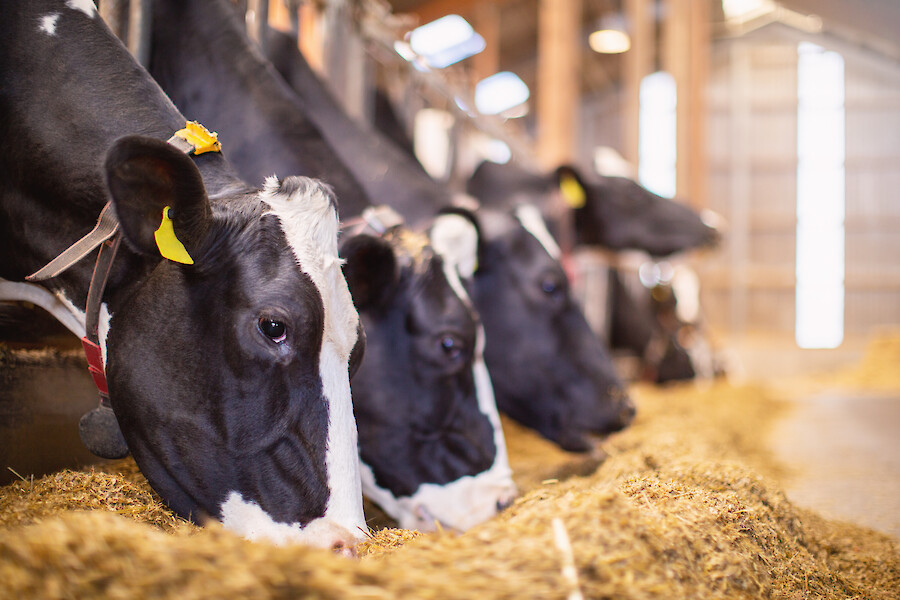
Feeding concepts against heat stress
In addition to adapting feeding and silage management, special feed concepts can provide relief from heat stress. These should be developed together with the feeding advisor and with a view to the operational requirements. The following components have proven successful in coping with heat stress and are therefore also included in feed concepts against heat stress:
Due to the heat stress in spring and summer and the associated adapted feeding behavior of dairy cattle, their acid-base balance can tip. Excessive deviations from the norm can promote the development of (metabolic) acidosis. Feed additives such as sodium bicarbonate have a "buffering" effect on the intermediate pH value and thus keep it in balance. This counteracts disturbances of the acid-base balance. Sodium bicarbonate can be integrated into the ration via compound feed or mineral feed. Feed analyses should be carried out to check the ration calculation and mixing accuracy.
Due to the reduced feed intake during heat stress, it is essential - in addition to increasing the feed intake - to optimize the utilization of the feed. For this purpose, live yeast (lat. Saccharomyces cerevisiae) is suitable as an additive in the feed. Live yeast is mainly used in feeds for high-performance cows. They serve to strengthen rumen health by stabilizing the pH value in the rumen and thus positively influence rumen function. As a result, the activity of the rumen microbes remains in balance. The cellulose-degrading bacteria improve crude fiber digestion and thus feed efficiency. The optimal supplementation takes place in combination with the basic ration. Therefore, it is recommended to use it over the mineral feed (e.g. deukaMin NG cow LAC+yeast).
Using the right milk yield feed to combat heat stress
The choice of milk performance feed (MLF) has a major influence on the feed intake of dairy cows. Thus, they form an important pillar in preventing performance losses due to heat stress. The following criteria indicate what you should look for when choosing an MLF for your high-yielding cows:
- (Proportionate) fixed component frame
- Palatable components
- Guaranteed high content of rumen-stable starch
- Guaranteed high content of digestible crude fiber
- Guaranteed high content of usable crude protein at the duodenum (nXP)
- Guaranteed high content of rumen stable protein (UDP)
- A high level of mineralization and active ingredients in line with requirements
- Fits the basic ration
Adapted water supply during heat stress
Both increased performance and elevated temperatures noticeably increase the water requirements of cows. It is not uncommon for dairy cows to consume up to 150 liters daily. In order to meet the herd's water needs, some adjustments in watering management are advisable - at least temporarily. After all, the average amount of milk produced by cows is directly related to the amount of water consumed.
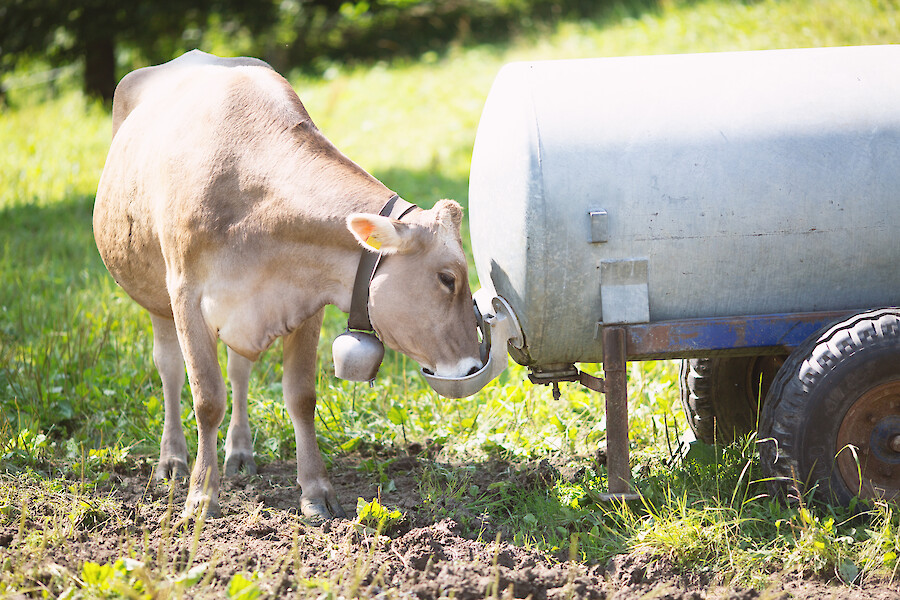
-
- Enable your herd to absorb large amounts of water within a short period of time. Long, open trough drinkers with open water surfaces and a high flow rate are therefore preferable to self-drinkers.
- Allow your animals continuous access to the drinkers. You can achieve this by ensuring a balanced animal/drinker ratio. 10% of the herd should be able to access water at any one time.
- Check waterers regularly for malfunctions.
- Consider adequate spacing between individual troughs when selecting locations.
- Allow for animal-friendly drinking. The upper edge of the trough should not exceed 80 to 85 cm from the level of the standing surface.
- Offer additional water to lactating animals after milking. 30 to 50% of cows drink within one hour after milking.
- Check watering troughs regularly for contamination and clean if necessary. However, especially in the summer, warm temperatures can cause germs and microorganisms to multiply in the water. The water must always be of drinking water quality.
- Finally, make sure to offer cold water. This provides additional cooling for the animals.
Conclusion
- High temperatures have an impact on the performance of dairy cattle.
- Already at a temperature of 22 °C one speaks of heat stress.
- To regulate the temperature, a mix of different measures has proven successful. These include the installation of a ventilation or cooling system, adapted barn management and structural adjustments to the barn.
- Adjusting the feeding is equally important. Various measures can be taken to optimize the ration in spring and summer and thus adapt it to the animals' changed needs.
- Adjusting the watering management to ensure an adequate water supply rounds off the mix of measures for heat stress.
Contact person

Contact person



